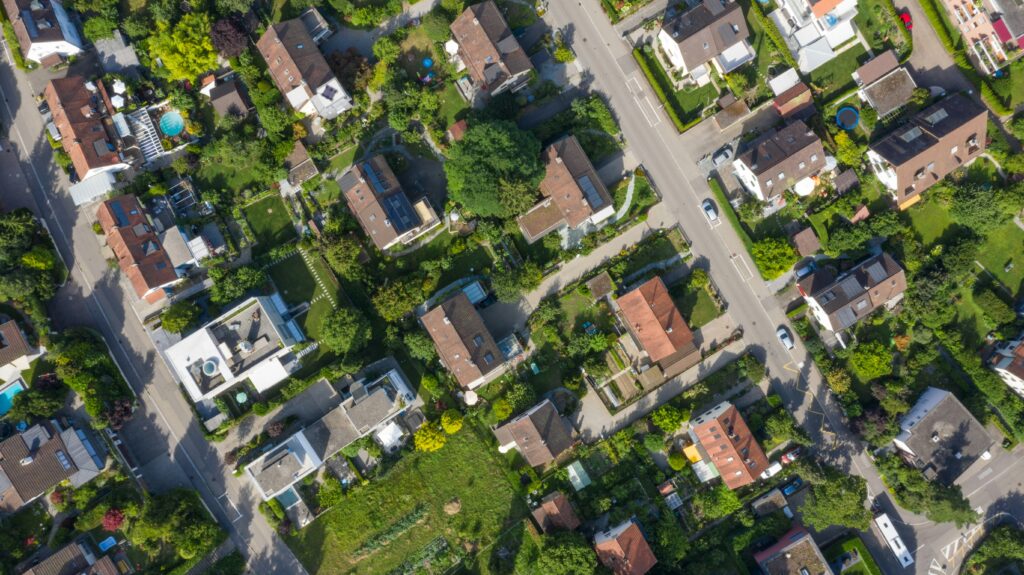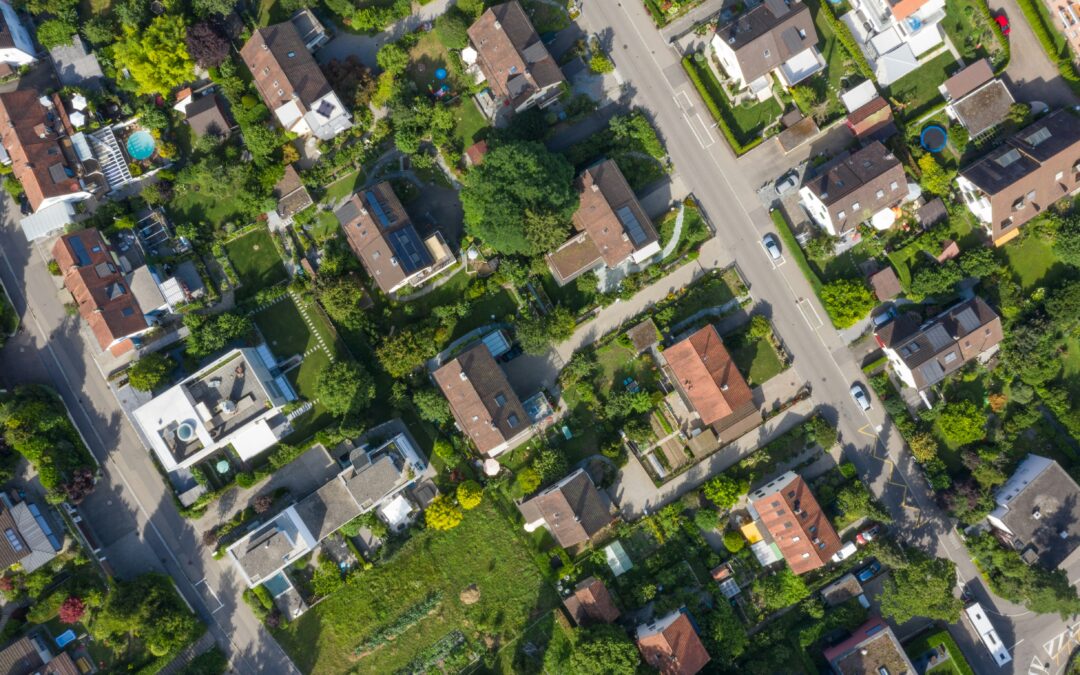Community solar programs have emerged as a powerful solution for expanding access to renewable energy, particularly for those who cannot install solar panels on their own properties. The programs have primarily focused on ground-mount solar, but an increasing number of states are now including rooftop projects in their scope. Installing systems on the built environment offers several benefits and advantages, including:
- Grid Benefits: Reduces transmission losses by generating electricity near consumption points
- Efficient Land Use: Utilizes existing structures rather than consuming additional land
- Quicker Execution: Can be faster to bring online compared to ground-mount systems that need to go through different levels of environmental review.
- Community Engagement: Create visible renewable energy projects that connect directly with local communities
- Economic Inclusion: Many programs specifically target benefits for low and moderate-income households
- Monetization of Underutilized Space: Provides revenue opportunities for building owners with available roof space
What is Rooftop Community Solar?
Unlike traditional community solar projects, which are often built on open land in rural or semi-rural areas, rooftop community solar utilizes existing commercial, industrial, or institutional rooftops to host solar arrays. These projects allow multiple subscribers to benefit from a single solar installation, receiving credits on their electricity bills based on their share of the solar energy produced.

Leading States in Rooftop Community Solar
Maryland: From Pilot to Permanent
Maryland has transformed its Community Solar Pilot Program into a permanent fixture of the state’s energy landscape. Initially launched in 2015, the pilot program was extended to seven years in 2019 before being made permanent through House Bill 908 in April 2023.
Key features of Maryland’s program include:
- No cap on total community solar capacity, with individual projects limited to 5 megawatts
- At least 40% of each project’s capacity must be reserved for low and moderate-income (LMI) subscribers, an increase from the 30% requirement during the pilot phase
- LMI subscribers can self-attest to their income status, simplifying participation
- Utilities use consolidated billing to make the process more user-friendly
- Participating utilities include Baltimore Gas & Electric (BGE), Delmarva Power & Light, Pepco, and Potomac Edison
- Projects can be located on commercial rooftops, industrial areas, brownfields, landfills, and farmland using agrivoltaics
- Robust consumer protections, including prohibitions against unreasonable fees and clear contract disclosure requirements
- As of late 2022, approximately 88 MW of community solar capacity was online, with more projects in development
New York: Urban Rooftop Innovation
New York has established itself as a leader in community solar, with particular attention to urban rooftop installations through its Community Distributed Generation (CDG) Program.
Notable aspects include:
- The NY-Sun Initiative and Reforming the Energy Vision (REV) Plan have made New York a top state for community solar
- Multiple incentives are available, including the Base Solar Incentive, Value of Distributed Energy Resources Tariff (VDER), and the Investment Tax Credit (ITC)
- Specific community solar incentives include the Community Adder and the Inclusive Community Solar Adder (ICSA)
- Urban focus includes projects on New York City Housing Authority (NYCHA) rooftops, developed by companies like Solstice to benefit local communities
- The program is accessible to anyone who cannot install solar on their property due to roof space limitations, shading issues, or zoning restrictions
Illinois: Multiple Pathways for Participation
Illinois offers several avenues for community solar participation through its Illinois Shines (Adjustable Block Program) and Illinois Solar for All initiative.
The program includes:
- Traditional Community Solar (TCS) projects up to 5 MW in size
- Community-Driven Community Solar (CDCS) projects designed for more direct community benefits
- Illinois Solar for All (ILSFA) specifically targets income-eligible households (at or below 80% of Area Median Income), nonprofits, and public facilities serving low-income communities
- The Climate and Equitable Jobs Act (CEJA) allocated funding for 250 MW of pending community solar projects and committed to an additional 150 MW per year
- As of the first half of 2024, Illinois had approximately 287 MWac of community solar capacity installed
- While most projects are ground-mounted, urban rooftop installations are being developed
Massachusetts: Innovative Financing and Accessibility
Massachusetts has a well-established community solar program that includes rooftop projects, especially in areas where traditional ground-mounted solar is not feasible.
Key elements include:
- The SMART (Solar Massachusetts Renewable Target) Program replaced the SREC II Carve-Out program in 2018
- The program is designed to support 1,600 MW of solar energy development
- It offers Solar Tariff Generation Units (STGU) instead of SRECs, providing financial credits to community solar projects
- Rooftop projects are emphasized in densely populated areas with limited land availability
Minnesota: Pioneer in Community Solar Gardens
Minnesota’s community solar garden program includes rooftop installations, particularly in urban and suburban areas.
Program details:
- The Solar*Rewards Community Program, administered by Xcel Energy, provides financial incentives for solar garden development
- The Community Solar Gardens (CSG) Program, launched in 2013, has led to nearly 800 MW of community solar capacity
- Updated program rules include annual growth caps and a requirement that 55% of each community solar garden’s capacity must be reserved for low-income households, public interest subscribers, or affordable housing providers
- The Low and Moderate-Income (LMI) Accessible Community Solar Garden Program increases access for underserved communities
- Rooftop installations help maximize land use efficiency in developed areas
Florida: Utility-Driven Initiatives
Florida’s community solar programs, while primarily focused on ground-mounted installations, include some rooftop projects, especially in densely populated areas.
Program highlights:
- The FPL SolarTogether Program allows customers to pay a fixed monthly fee per kilowatt (kW) of solar panels and receive bill credits based on energy production
- Credit rates start at $0.036 per kWh in the first year, increasing annually thereafter
- The program includes 20 solar projects, each around 74.5 MW, totaling 1,490 MW
- 75% of capacity is reserved for commercial and industrial sectors, with 25% for residential customers
- No long-term contracts, with subscriptions transferable to any residence within FPL’s service area
- Duke Energy’s Community Solar Program uses a random selection process for subscription opportunities
- Customers subscribe to kilowatt blocks of solar power with a monthly subscription fee added to their regular bill
Virginia: Expanding Shared Solar Options
Virginia’s shared solar program, expanded in 2022, includes incentives for projects on rooftops and other non-traditional sites.
Key features:
- Established under Virginia Code § 56-594.3, the program allows Dominion Energy Virginia customers to participate in offsite shared solar projects
- The overall program cap is 200 MW, with an additional 150 MW expansion approved in 2024
- At least 30% of subscribers must be low-income
- A new 50 MW shared solar program has been established in Appalachian Power’s (APCo) territory
- Special incentives are available for projects located on rooftops, brownfields, landfills, or dual-use agricultural facilities
New Jersey: Transitioning to Permanence
New Jersey’s Community Solar Energy Program (CSEP) was transitioned from a pilot to a permanent program in August 2023.
Program details:
- Designed for individuals who cannot install solar panels on their rooftops, including renters and those in multi-family buildings
- At least 51% of the capacity of each community solar project must be subscribed by LMI households
- For Energy Year 2024, the CSEP allocated 225 MW of capacity across four Electric Distribution Company territories
- The program aims to achieve a cumulative capacity of 750 MW of community solar by August 2026
- Rooftop projects are expected to play an important role, particularly in densely developed areas
Connecticut: Doubled Program Capacity
Connecticut’s Shared Clean Energy Facility (SCEF) Program has evolved significantly to democratize access to solar energy across the state. This innovative program allows residents and businesses to benefit from solar power without installing panels on their own properties. It also supports low-income households by requiring that at least 10% of every project serve low-income customers.
The SCEF Program, administered by the Connecticut Department of Energy and Environmental Protection in collaboration with state utilities, has expanded considerably since its 2018 pilot:
- Annual capacity doubled from 25 MW (2020-2022) to 50 MW (2023-2025)
- Project size limits increased from 100 kW – 4 MW to 100 kW-5 MW
- The program was recently extended from 6 to 8 years through Public Act 24-31
The program operates through a competitive annual bidding process where utilities issue RFPs for clean energy projects. Subscribers receive monthly bill credits for up to 20 years at approximately 2.5 cents per kWh, with no upfront costs.
A significant development came in 2022 with Senate Bill 176, which removed restrictions on rooftop projects. This change allows:
- Full utilization of roof square footage (no longer limited by onsite load)
- Larger rooftop installations, potentially up to the 5MW limit
This policy shift bore fruit in August 2023 with Connecticut’s first operational SCEF rooftop project—a 2.1 MW installation on an industrial property in Milford, demonstrating the viability of commercial rooftops for community solar.
Corporate Leadership in Rooftop Community Solar
Major corporations are increasingly leveraging their vast rooftop assets for community solar:
- Walmart has invested in 74 rooftop community solar projects developed by Solar Landscape in Maryland and Illinois, generating nearly 43 MW of capacity to serve over 3,600 homes, with a focus on low and moderate-income households
- Additionally, Walmart is partnering with Nexamp to develop 31 community solar projects across five states (Maine, Massachusetts, New York, Illinois, and Minnesota), generating over 120 MW of solar energy to benefit approximately 8,000 residential customers
- Walmart has also teamed with Pivot Energy on 19 solar projects, including 15 community solar projects across Illinois, Colorado, Maryland, Delaware, and California, facilitating 72 MW of community solar capacity
- Prologis, a real estate investment trust, is developing community solar on its commercial and industrial rooftops in partnership with Solar Landscape, with projects already operational in New York, Illinois, and California, aiming for 1 gigawatt of solar capacity across its portfolio by 2025
- Brixmor is leasing rooftops to third-party developers like Blue Sky Utility in California and Solar Landscape, supporting community solar programs in states including New York, Connecticut, and Massachusetts
Looking Forward
As states continue to refine their community solar policies and more corporations make their rooftops available, we can expect significant growth in rooftop community solar installations. These projects represent a crucial component of our transition to a more distributed, equitable, clean energy system.
The success of these programs demonstrates that with the right policies and partnerships, the vast, underutilized rooftop space across America can become a powerful asset in our renewable energy portfolio while expanding clean energy access to all communities.


